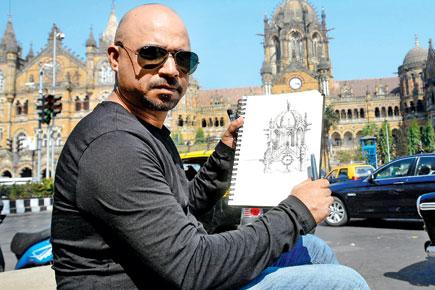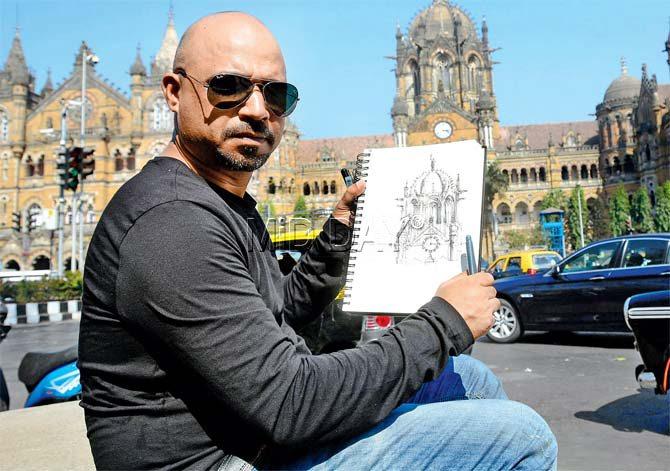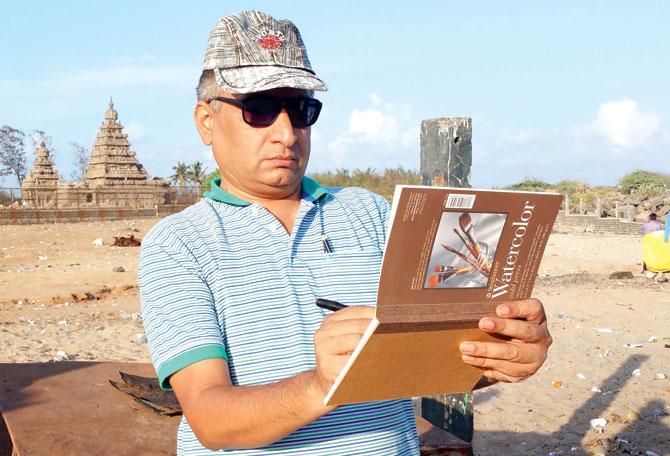Indian artists join petition to request ASI to abolish bizarre law that prohibits them from sketching at heritage sites

Kishan Dev, a member of Urban Sketchers Mumbai, and other artists from the country have joined a petition against the Ancient Monuments and Archaeological Sites and Remains Act 1959, which prohibits the copying and filming of protected monuments
On a sunny April morning in 2015, artist Kishan Dev and six other members of the Urban Sketchers Mumbai, made it to the Elephanta Caves — 10 km away on a ferry ride from the Gateway of India — for a weekly sketch meet. Urban Sketchers is an international non-profit organisation started by Seattle-based journalist and illustrator Gabriel Campanario in 2009 to foster a global community of artists who practice on-location drawing. Urban Sketchers Mumbai is one of its affiliate.

Kishan Dev, a member of Urban Sketchers Mumbai, and other artists from the country have joined a petition against the Ancient Monuments and Archaeological Sites and Remains Act 1959, which prohibits the copying and filming of protected monuments. Pic/Bipin Kokate
"As sketchers, we love to draw the cities we live in, always on location, not from photos or memory," says Dev, who has been associated with the group for two years. It was during one of their outings that the group zeroed in on the Elephanta Caves for its historical value.
Quiet and picturesque, the 7th century caves with their magnificent stone carvings offered the perfect landscape for these artists to unleash their creativity. "On reaching the spot, we found a corner where we could draw without disruption. We normally don't sit together because everybody needs space while sketching. I found myself a quiet place in the main cave from where I could get a view of the sculptures," reminisces the 40-year-old.
However, almost immediately, security guards emerged and began to shoo them away. "They started chasing us away like we had just committed an offence. We were told that in the eyes of the Archeological Survey of India (ASI), we were, in fact, trespassers. And our crime was sketching," he says.
According to the Ancient Monuments and Archaeological Sites and Remains Act 1959, copying and filming of protected monuments is prohibited across the country. In other words, drawing, photography and preparation of cinematographic film [and video film] with the aid of a hand-camera that is capable of taking films of not more than eight millimeters is forbidden by law. The fine is Rs 500 but rarely asked for, since one has to file an FIR in order to penalise offenders.
"Funnily, while we were there, many visitors were touching the sculptures and pillars and even taking photographs, but they weren't pulled up. We tried to reason with the officials that our objective was not to 'copy' but offer our own rendition of the view, but they said we had to have prior permission to sketch," he adds.

While he was sketching at Mahabalipuram's Shore temple, Chennai resident Ganpathy Subramaniam was asked by local security officials if he had permission to do so. Subramaniam has now launched a petition on Change.org to have the ASI knock down what he thinks is an archaic law
In India, there are about 5,000 historical sites that fall under the ASI, including the CST station, Worli Village, Jogeshwari caves, Mandapeshwar Caves in Borivli, the monolithic bass relief depicting Shiva at Parel village and Buddhist caves at Kanheri, among others. However, 24-year-old Aparajita Nath confesses to have been 'harassed' even in areas that don't fall under the ASI's purview. "It was in September 2014 that a couple of artist friends and I decided to sketch at the Hiranandani Powai market. The moment we got started, some men on bikes came charging towards us and threatened to confiscate our books if we don't leave. According to them, it was a private property. It was almost impossible to reason with those goons," she recalls.
Nath, who was working as a research assistant at IIT Bombay, has moved to the Netherlands to pursue her PhD in Acoustic Wavefield Imaging, and is now part of Urban Sketchers Rotterdam. She got a pleasant surprise when she visited a museum in Netherlands. "Here, at Rijksmuseum, authorities have banned cameras in order to encourage sketching. It was such a warm feeling to know we could draw without being chased away," she says.
Artists have now got together to fight what is an archaic rule. Last week, Chennai-based artist, Ganpathy Subramaniam launched an online campaign on Change.org asking the ASI to allow sketching of historical monuments, without having to obtain permission. Subramaniam, a member of the Chennai Weekend Artists, was asked to get permission in order to render the Shore temple in Mahabalipuram on his sketch pad. "When we say sketching, it is from an artistic point of view and not for a survey using equipment. While it is perfectly allowed to photograph or shoot videos of all these monuments, the rule to prevent sketching needs amending," he says.
Within seven days, the petition has garnered over 800 signatures, including from the likes of Dev and his group from the city. "Sketching on location is a movement that is gaining momentum across the globe. It aids spending time with subjects of interest, and enjoying the art form at a deeper level," he says. "I feel it is an issue that hasn't been amended because it was never brought to anyone's notice," says Subramaniam, a former software consultant and now a full-time artist.
Tejas Garge, an ASI official, says sketch artists would often inconvenience other tourists. "When you have 50 people sitting inside a temple or cave premises with their canvas and easels for two hours or more, it's bound to cause inconvenience to other visitors. Imagine the agony of a tourist who wants to move around and appreciate the architecture," he says. While Garge empathises with the artist community, he feels acquiring permission is essential for the maintenance of law and order. You need to apply for permission at the ASI's regional office.
"It is a misconception that we do not allow artists to draw or paint on location. All we are asking for is the artists get permission beforehand," says Garge, who works in Aurangabad. In a month, the ASI official receives 60 emails requesting permission.
"We normally respond within 5 days," he adds. Permission is usually given on the basis of intention. "Academic pursuits on site are encouraged," he adds. Ajay Nayak, a Mumbai-based architect who runs the Social Studio which educates students about social issues, feels sketching is an essential skill for those who want to grow as artists. "We evolve as architects and future designers through sketching trips to heritage locales. As the hand draws, it builds the muscle memory of the mind to capture the aesthetics and details far better than copying from pictures."
 Subscribe today by clicking the link and stay updated with the latest news!" Click here!
Subscribe today by clicking the link and stay updated with the latest news!" Click here!










